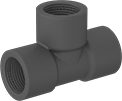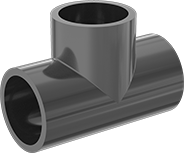How to Identify and Measure Fittings
Pipe size is an industry designation, not the actual size. View information about how to measure threaded and unthreaded pipe and pipe fittings.
More
Flame-Retardant PVDF Pipe Fittings for Chemicals
- For Use With: Chlorine, Salt Water, Solvents
- Temperature Range: 40° to 280° F
- Specifications Met: ASTM D3222, UL 94 V-0
- Pipe Nipples and Pipe: Use Schedule 80 PVDF Plastic
- Flanges: Use Class 150 PVDF Plastic
These fittings meet UL 94 V-0 for flame retardance, so they delay the spread of flames to valuable equipment. They are made of PVDF (polyvinylidene fluoride), which is comparable to Kynar, and has the chemical resistance to stand up to solvents and other harsh substances. Also known as Schedule 80 fittings, they have thick walls for heavy duty chemical processing applications. When connecting to pipe, apply a non-hardening, plastic-compatible sealant to the male threads to prevent leaks. Tape or sealants with PTFE are not recommended for plastic-to-plastic threaded connections. When making a threaded connection be careful not to overtighten the threads. To prevent cracks and leaks, finger tighten the fitting, then wrench-tighten one to two turns. Fittings meet ASTM D3222 specifications and testing requirements for material quality.
Warning: Never use plastic pipe fittings and pipe with compressed air or gas.
Sealants cannot be sold to Colorado, Connecticut, District of Columbia, Delaware, Illinois, Indiana, Massachusetts, Maryland, Maine, Michigan, New Hampshire, New Jersey, Northern Virginia, New York, Ohio, Pennsylvania, Rhode Island, or Utah due to local VOC (Volatile Organic Compounds) regulations.

| Pipe Size | Material | Color | Max. Pressure | Each | |
NPT Threads | |||||
|---|---|---|---|---|---|
| 1/2 | PVDF Plastic | Red | 290 psi @ 72° F | 00000000 | 000000 |
| 3/4 | PVDF Plastic | Red | 230 psi @ 72° F | 00000000 | 00000 |
| 1 | PVDF Plastic | Red | 210 psi @ 72° F | 00000000 | 000000 |
| 1 1/2 | PVDF Plastic | Red | 160 psi @ 72° F | 00000000 | 000000 |
| 2 | PVDF Plastic | Red | 140 psi @ 72° F | 00000000 | 000000 |
| Non-Hardening Thread Sealant (8-oz. Brush-Top Can) | 000000 | Each | 000000 |
High-Purity PVDF Pipe Fittings for Corrosive Chemicals
Made of PVDF that’s finished to a 12 Ra smoothness, these fittings handle some of the harshest chemicals without leaching contaminants into your line. They won’t accumulate particles and are easy to clean, thanks to their smoothness. Comparable to Kynar, these fittings handle most organic solvents that would dissolve CPVC, and chlorine or nitric acid that would weaken polypropylene. You can use them at higher temperatures than CPVC and polypropylene. These fittings meet UL 94 V-0 and FM standards for flame retardance. They’re also FDA compliant for direct contact with food, and they meet ASTM requirements for dimensions and tolerances.
Connect them to pipe with socket fusion welding for a strong, permanent bond. Use a socket fusion tool with a heater bushing (sold separately) that matches your pipe size.

- For Use With: Chlorine, Deionized Water, Hydrochloric Acid, Nitric Acid, Oil, Phosphoric Acid, Salt Water, Solvents
- Temperature Range: -40° to 270° F
- Specifications Met: ASTM D3261, FDA Compliant 21 CFR 177.2510, FM 4910, UL 94 V-0
- Pipe Nipples and Pipe: Use SDR 21 PVDF Plastic
- Flanges: Use PVDF Plastic
| Pipe Size | Socket Dp. | Material | Color | Max. Pressure | Each | |
| 1/2 | 37/64" | PVDF Plastic | White | 230 psi @ 72° F | 0000000 | 000000 |
| 3/4 | 5/8" | PVDF Plastic | White | 230 psi @ 72° F | 0000000 | 00000 |
| 1 | 45/64" | PVDF Plastic | White | 230 psi @ 72° F | 0000000 | 00000 |
| 1 1/2 | 59/64" | PVDF Plastic | White | 230 psi @ 72° F | 0000000 | 000000 |
| 2 | 1 5/64" | PVDF Plastic | White | 230 psi @ 72° F | 0000000 | 000000 |

- For Use With: Chlorine, Deionized Water, Hydrochloric Acid, Nitric Acid, Oil, Phosphoric Acid, Salt Water, Solvents
- Temperature Range: -40° to 270° F
- Specifications Met: ASTM D3222, FDA Compliant 21 CFR 177.2510, FM 4910, UL 94 V-0
- Seal Material: Viton® Fluoroelastomer Rubber
- Seat Material: PTFE Plastic
Add a ball valve to control the flow in your line.
| Pipe Size | Flow Coefficient (Cv) | Vacuum Rating, in. of Hg | Port Type | End-to-End Lg. | Color | Max. Pressure | Each | |
PVDF Plastic | ||||||||
|---|---|---|---|---|---|---|---|---|
| 1/2 | 12.5 | 29.92 | Full | 3 13/16" | White | 230 psi @ 72° F | 0000000 | 0000000 |
| 3/4 | 28 | 29.92 | Full | 4 9/32" | White | 230 psi @ 72° F | 0000000 | 000000 |
| 1 | 50.9 | 29.92 | Full | 4 23/32" | White | 230 psi @ 72° F | 0000000 | 000000 |
| 1 1/2 | 150 | 29.92 | Full | 6 1/16" | White | 230 psi @ 72° F | 0000000 | 00000000 |
| 2 | 230 | 29.92 | Full | 6 13/16" | White | 230 psi @ 72° F | 0000000 | 00000000 |

| Each | ||
| 00000000 | 0000000 |
Fiberglass Pipe Fittings for Corrosive Chemicals
- For Use With: Acetic Acid (75%), Alcohol, Calcium Chloride, Chlorine, Fuel Oil, Gasoline, Hydrochloric Acid (37%), Nitric Acid (10%), Oil, Phosphoric Acid, Salt Water (30%), Sodium Hydroxide (50%), Solvents, Sulfuric Acid (70%), Water
- Temperature Range: 32° to 200° F
- Specifications Met: ASTM D3567
These fittings have excellent corrosion resistance to handle a wide range of acids and other highly-corrosive chemicals. They are commonly used in metal surface treating applications, plating solution lines, and other chemical process applications. Reinforced with layers of fiberglass, they have better strength and durability than any of our other pipe fittings for chemicals. Fittings meet ASTM D3567 specifications for product dimensions.
To connect fittings to pipe, first sand the inside of the fitting and the end of the pipe to remove the surface finish. Next, mix the adhesive (sold separately) until the color is uniform with no streaks. Apply a thin layer of mixed adhesive to the sanded area of the pipe, approximately 1/8” thick. Repeat this process with the inside of the fitting, applying a layer approximately 1/16” thick. After sealant has been applied, push the fitting onto the pipe until it is fully engaged. Finally, use the adhesive-curing heat cable (sold separately) to cure the adhesive. Wrap the tape around the pipe and fitting at the joint, taking care to not overlap the tape. Once you have waited the full cure time, the pipe and fitting will be ready to use.
Warning: Never use plastic pipe fittings and pipe with compressed air or gas.

| Voltage | Max. Heat Output, °F | Lg. | Wd. | Thick. | Plug Type | Cord Lg. | Each | |
| 120V AC | 270° | 6 ft. | 1" | 1/8" | Two Prong | 6 ft. | 0000000 | 0000000 |
Chemical-Resistant PVDF Pipe Fittings for Food and Beverage
- For Use With: Beverage, Chlorine, Deionized Water, Food, Hydrochloric Acid, Phosphoric Acid
- Temperature Range: 0° to 240° F
- Specifications Met: FDA Compliant 21 CFR 177.2510, IEC 60695-11-10, NSF/ANSI 61
Made of PVDF, also known as Kynar, these fittings stand up to the harsh chemicals used to clean food processing lines. Unlike other plastic fittings, such as nylon and acetal fittings, they’ll resist degrading when exposed to strong alkali and highly acidic solutions. These fittings are FDA compliant and meet NSF/ANSI 61, so they're safe to make direct contact with food and drinking water. They also won't transfer tastes or odors to your food and beverages. Use them with both hot and cold substances. Since they're made of PVDF, these fittings can stand up to impact. They meet strict IEC standards for flame retardance, so they delay the spread of flames.
Since these fittings are threaded, you can take apart their connections for maintenance and repair. When connecting to another fitting, apply a non-hardening, plastic-compatible sealant to the male threads to prevent leaks. Tape or sealants with PTFE are not recommended for plastic-to-plastic threaded connections. When making a threaded connection, be careful not to overtighten the threads. To prevent cracks and leaks, finger tighten the fitting, then wrench-tighten one to two turns.
Warning: Never use plastic pipe fittings and pipe with compressed air or gas.
Sealants cannot be sold to Colorado, Connecticut, District of Columbia, Delaware, Illinois, Indiana, Massachusetts, Maryland, Maine, Michigan, New Hampshire, New Jersey, Northern Virginia, New York, Ohio, Pennsylvania, Rhode Island, or Utah due to local VOC (Volatile Organic Compounds) regulations.




























